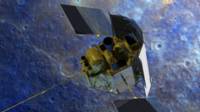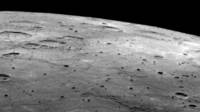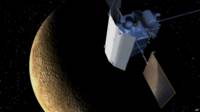- May 1, 2015
Share

The American space probe “Messenger”, who spent four years in orbit around Mercury, and more than a decade in space, down to the surface of Mercury, the press service of NASA.
The operation went according to plan. The unit mass of 513 kg, which spans only 3 meters, crashed into the planet’s surface at a speed of 14,000 kilometers per hour, resulting in the Mercury formed a new oval crater the size of a tennis court.
According to the NASA’s report, in the center of the flight control another 20 minutes recorded signals from the device, but this was due to too great a distance from the Earth to Mercury.
In 2011, the “Messenger” went into orbit around Mercury, where he was to stay, according to the plans of NASA, during only a year. His last fuel was spent on translation maneuver into an elliptical orbit on April 24.
As a result of the collision with the surface of the planet, “Messenger” was completely destroyed. The probe could crash into Mercury due to the fact that this planet is not dense atmosphere, which could burn the “Messenger”.
The mission of “Messenger” was extended twice, and during this time the data transmitted by the probe to the Earth, changed our understanding of Mercury.
“Messenger” NASA sent 270,000 photographs and 10 terabytes of data.

Among other things, that “Messenger” found that craters at Mercury’s poles have ice, but also found that the magnetic field of the planet is not focused on the center of the planet, and rejected by 10% of the planet’s axis of rotation.
For four years, “Messenger” circled the Mercury 4104 times in an elliptical orbit, approaching the planet at a distance of 96 kilometers.
Fall
To maintain this orbit, despite the attraction of the sun, every few months, “messenger” had to include its engine, thereby using the last of his fuel.
During the penultimate rendezvous with the planet, “Messenger” flying over the surface at an altitude of 300-600 meters.

Eight hours later, the probe crashed into Mercury. The exact path was calculated using data collected by the “messenger”.
The surface of Mercury is full of huge rocks, but the collision had happened to her, as was intended, at a fairly flat plain near the crater with a diameter of 370 km of Shakespeare, which remained after the fall of the ancient asteroid. The blow was a very acute angle.
The fall happened on the side of the planet facing away from Earth. This means that communication with the device at that time was not, and more than a thousand images of the last unit took with him to the grave.
“messenger” was able to study Mercury in great detail, which is not expected NASA specialists.
Many believed that he did not fly to the Mercury, not to mention the fact that the probe will go into orbit around the planet, and will collect data for four years, instead of the planned year.
But the “Messenger” will continue to help science and after his fall. He created a 16-meter crater on Mercury’s surface would be eroded due to cosmic radiation and downs of small meteorites. Such erosion craters makes darker.
By 2024 Mercury should arrive European and Japanese probe “BepiKolombo” that can measure how much darkened crater left by the “messengers”, so that scientists can better understand the process Space erosion.
No comments:
Post a Comment